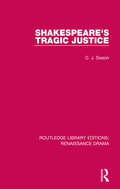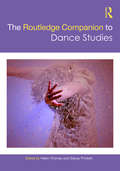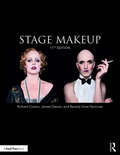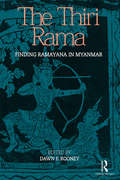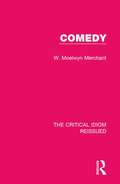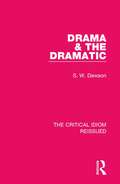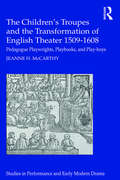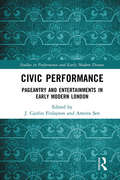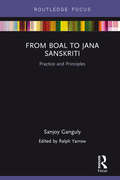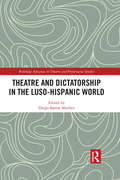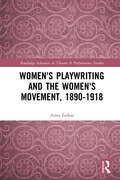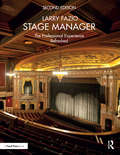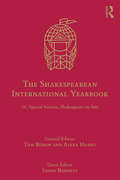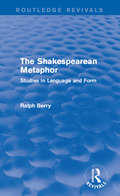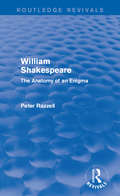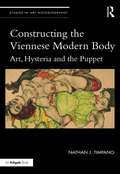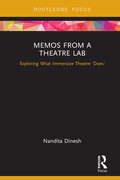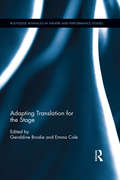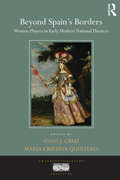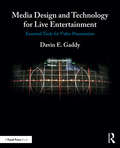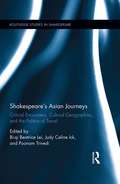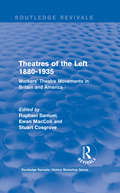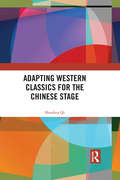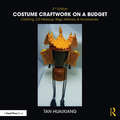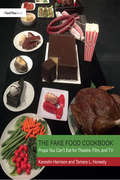- Table View
- List View
Shakespeare's Tragic Justice (Routledge Library Editions: Renaissance Drama)
by C. J. SissonThe problem of justice seems to have haunted Shakespeare as it haunted Renaissance Christendom. In this book, first published in 1963, four aspects of the problems of justice in action in Shakespeare’s great tragedies are explored. This study is based on the lifetime’s research of Elizabethan habits of mind by one of the most distinguished Shakespearean scholars, and will be of interest to students of English Literature, Drama and Performance.
The Routledge Companion to Dance Studies (Routledge Companions)
by Helen Thomas Stacey PrickettThe Routledge Companion to Dance Studies maps out the key features of dance studies as the field stands today, while pointing to potential future developments. It locates these features both historically—within dance in particular social and cultural contexts—and in relation to other academic influences that have impinged on dance studies as a discipline. The editors use a thematically based approach that emphasizes that dance scholarship does not stand alone as a single entity, but is inevitably linked to other related fields, debates, and concerns. Authors from across continents have contributed chapters based on theoretical, methodological, ethnographic, and practice-based case studies, bringing together a wealth of expertise and insight to offer a study that is in-depth and wide-ranging. Ideal for scholars and upper-level students of dance and performance studies, The Routledge Companion to Dance Studies challenges the reader to expand their knowledge of this vibrant, exciting interdisciplinary field.
Stage Makeup: Special Edition
by Richard Corson James Glavan Beverly Gore NorcrossWidely referred to as the "bible of stage makeup," the timely revision of this classic text addresses principles and techniques in the use of makeup for the contemporary performer. This extensive exploration of the application and use of stage makeup and makeup for a variety of performance venues covers all aspects in detail and contains over 1000 photographs, drawings, and diagrams demonstrating step-by-step procedures. Thoroughly updated and revised, this classic text remains accurate and comprehensive, providing information from which all readers – whether students new to the field or seasoned, professional makeup artists – will benefit. New to this edition: Updated full-color photography throughout Expanded information on makeup design and application 48 new step-by-step instructions in color Expanded chapter on modeling with highlights and shadows New chapter on cross-gender makeup New instruction on making dentures, noses, and face casting New instructions for creating zombies, animals, aging effects, and trauma Expanded information on makeup for television and film Up-to-date information on Special Effects makeup Up-to-date information on prosthetic makeup Updated chapters on facial hair and wigs Updated resources for products, advanced training, and health and safety
The Thiri Rama: Finding Ramayana in Myanmar
by Dawn RooneyThe Thiri Rama – or the Great Rama – was written for court performance and is the only known illustrated version of the Ramayana story in Myanmar. Based on palm-leaf manuscripts and scenes carved on over 300 sandstone plaques at a mid-nineteenth-century Buddhist pagoda west of Mandalay in Myanmar, this book presents an original translation of the Thiri Rama rendered in prose. The volume also includes essays on the history and tradition of the Ramayana in Myanmar as well as the cultural context in which the play was performed. It contains many helpful resources, incorporating a glossary and a list of characters and their corresponding personae in Valmiki’s Ramayana. With over 250 fascinating visuals and core text contributions by distinguished Burmese scholars, U Thaw Kaung, Tin Maung Kyi, and U Aung Thwin, this book will greatly interest scholars and researchers of South and Southeast Asian culture, literary forms, epics, art and art history, theatre and performance studies, religion, especially those concerned with Hinduism, as well as folklorists.
Comedy (The Critical Idiom Reissued #20)
by Moelwyn MerchantFirst published in 1972, this work pursues the question ‘what is comedy?’ In its quest for an answer it explores critical theory, psychology, sociology and metaphysics. It also examines the classical origins of comedy, different kinds of comedy, the rituals of comedy, its relationship with other idioms such as ‘satire’, irony’ and ‘farce’, and compares two major traditions: ‘Aristophanic’ and ‘Shakesperean’ comedy. In doing so, the book demonstrates the indefinable and flexible nature of comedy. This work will be a valuable resource to those studying drama, and in particular, those focusing on classical and Shakespearean plays.
Drama & the Dramatic (The Critical Idiom Reissued #10)
by S. W. DawsonFirst published in 1970, this book explores drama as literature and provides critical overviews of different aspects of drama and the dramatic. It first asks what a play is, before going on to examine dramatic language, action and tension, dramatic irony, characters and drama’s relationship with modern criticism and the novel. This book will be a valuable resource to those studying drama and English literature.
The Children's Troupes and the Transformation of English Theater 1509-1608: Pedagogue, Playwrights, Playbooks, and Play-boys (Studies in Performance and Early Modern Drama)
by Jeanne McCarthyThe Children’s Troupes and the Transformation of English Theater 1509–1608 uncovers the role of the children’s companies in transforming perceptions of authorship and publishing, performance, playing spaces, patronage, actor training, and gender politics in the sixteenth century. Jeanne McCarthy challenges entrenched narratives about popular playing in an era of revolutionary changes, revealing the importance of the children’s company tradition’s connection with many early plays, as well as to the spread of literacy, classicism, and literate ideals of drama, plot, textual fidelity, characterization, and acting in a still largely oral popular culture. By addressing developments from the hyper-literate school tradition, and integrating discussion of the children’s troupes into the critical conversation around popular playing practices, McCarthy offers a nuanced account of the play-centered, literary performance tradition that came to define professional theater in this period. Highlighting the significant role of the children’s company tradition in sixteenth-century performance culture, this volume offers a bold new narrative of the emergence of the London theater.
Civic Performance: Pageantry and Entertainments in Early Modern London (Studies in Performance and Early Modern Drama)
by J. Caitlin Finlayson Amrita SenCivic Performance: Pageantry and Entertainments in Early Modern London brings together a group of essays from across multiple fields of study that examine the socio-cultural, political, economic, and aesthetic dimensions of pageantry in sixteenth and seventeenth-century London. This collection engages with modern interest in the spectacle and historical performances of pageantry and entertainments, including royal entries, progresses, coronation ceremonies, Lord Mayor’s Shows, and processions. Through a discussion of the extant texts, visual records, archival material, and emerging projects in the digital humanities, the chapters elucidate the forms in which the period itself recorded its public rituals, pageantry, and ephemeral entertainments. The diversity of approaches contained in these chapters reflects the collaborative nature of pageantry and civic entertainments, as well as the broad socio-cultural resonances of this form of drama, and in doing so offers a study that is multi-faceted and wide-ranging, much like civic performance itself. Ideal for scholars of Early Modern global politics, economics, and culture; literary and performance studies; print culture; and the digital humanities, Civic Performance casts a new lens on street pageantry and entertainments in the historically and culturally significant locus of Early Modern London.
From Boal to Jana Sanskriti: Practice and Principles
by Sanjoy GangulyJana Sanskriti is internationally recognised as the most iconic post-Boalian Theatre of the Oppressed operation in the world today. This fully illustrated book by the Bengali company's founder and artistic director Sanjoy Ganguly, edited by Ralph Yarrow, collects and explains their programme of workshop exercises, placing them in the context of their social and activist work. A set of interviews with Ganguly complements these practical sequences, drawing in topics such as the role of the joker, the nature of development, participation and agency, aesthetics as transformation, and Theatre of the Oppressed in the context of a market economy.
Theatre and Dictatorship in the Luso-Hispanic World (Routledge Advances in Theatre & Performance Studies)
by Diego SánchezTheatre and Dictatorship in the Luso-Hispanic World explores the discourses that have linked theatrical performance and prevailing dictatorial regimes across Spain, Portugal and their former colonies. These are divided into three different approaches to theatre itself - as cultural practice, as performance, and as textual artifact - addressing topics including obedience, resistance, authoritarian policies, theatre business, exile, violence, memory, trauma, nationalism, and postcolonialism. This book draws together a diverse range of methodological approaches to foreground the effects and constraints of dictatorship on theatrical expression and how theatre responds to these impositions.
Women's Playwriting and the Women's Movement, 1890-1918 (Routledge Advances in Theatre & Performance Studies)
by Anna FarkasThe influence of the women’s movement has long been a scholarly priority in the study of British women’s drama of the late nineteenth and early twentieth centuries, but previous scholarship has largely clustered around two events: the New Woman in the 1890s and the suffrage campaign in the years before the First World War. Women’s Playwriting and the Women’s Movement, 1890–1918 is the first designated study of British women’s drama from a period of exceptional productivity and innovation for female playwrights. Both the British theatre and women’s position within British society underwent fundamental changes in this period, and this book shows how female dramatists carefully negotiated their position in the heated debates about women’s rights that occurred at this time, while staking out a place for themselves in an evolving theatrical landscape. Farkas also identifies the women’s movement as a key influence on the development of female-authored drama between 1890 and 1918, but argues that scholarly prioritizing of the "radicalism" of work associated with the New Woman and the suffrage campaign has had a distorting effect in the past. Ideal for scholars of British and Victorian theatre, Women’s Playwriting and the Women’s Movement, 1890–1918 offers a new perspective which emphasizes the complexity of women playwrights’ engagement with first-wave feminism and links it to the diversification of the British theatre in this period.
Stage Manager: The Professional Experience—Refreshed
by Larry FazioStage Manager: The Professional Experience–Refreshed takes the reader on a journey through all aspects of the craft of stage management in theatre, including the technological advancements that have come to theatre and the stage manger’s job. Chapters are laid out to reflect the order in which stage managers experience and perform their work: what makes a good stage manager, seeking the job, building a resume, interviewing for the job, and getting the job (or not getting the job). Included are chapters on the chain of command, working relationships, tool and supplies, creating charts, plots, plans and lists, the rehearsal period, creating the prompt book, calling cues, and the run of the show. These are just some of the many topics covered in this book. In addition, the author uses interviews with stage management professionals in various stages of production, providing another view of how the stage manager is perceived and what is expected form the work of the stage manager. Fifteen years after the original publication of Stage Manager: The Professional Experience, this new and refreshed edition is now in color to help clarify and illustrate points in the text. It is fully updated to reflect the the world of computerized technology: smart phones, thinly designed laptops, tablets, use of email and text messaging, storing and sharing files and information in cloud-based apps. Then there are the innovations of automation–electronically moving scenery, scenic projections–casting images and patterns on the stage; moving lights; LED luminaires; lasers; and greater use of fog and haze machines. In addition, the extensive glossary of more than 600 terms and phrases had been extend to well over 700, providing and excellent professional vocabulary for anyone hoping to be a theatre stage manager or already working in the field.
The Shakespearean International Yearbook: 16: Special Section, Shakespeare on Site (The Shakespearean International Yearbook)
by Tom Bishop Alexa HuangShakespearean performances regularly take place at both historic sites and locations with complex resonances, such as Shakespeare’s Globe Theatre in London and the royal castle of Hamlet – Elsinore – in Denmark. The present issue of the Shakespeare International Yearbook examines the impact of specificities such as festivals and performance sites on our understanding of Shakespeare and globalization. Contributions survey the present state of Shakespeare studies and address issues that are fundamental to our interpretive encounter with Shakespeare's work and his time, across the whole spectrum of his literary output.
Routledge Revivals (1990): Studies in Language and Form
by Ralph BerryFirst published in 1978, this book represents a study of the ways in which Shakespeare exploits the possibilities of metaphor. In a series of studies ranging from the early to the mature Shakespeare, the author concentrates on metaphor as a controlling structure — the extent to which a certain metaphoric idea informs and organises the drama. These studies turn constantly to the relations between symbol and metaphor, literal and figurative, and examine key plays such as Richard III, King John, Henry V, Romeo and Juliet, Troilus and Cressida, and Coriolanus. They also provide a key to The Tempest which is analysed in terms of power and possession — the dominant motif.
Routledge Revivals (1990): The Anatomy of an Enigma
by P. E. RazzellFirst published in 1990, the aim of this book is to reveal the William Shakespeare whose life has been obscured by centuries of literary mythology. It unravels a series of strands in order to understand the man and the major influences which shaped his life and writing. The first part advances the thesis that his relationship with his father directly influenced the character of Falstaff — helping to not only explain key events in his father’s life but also critical events in his own biography. This thesis not only illuminates the Falstaff plays but also a number of other works such as Hamlet. The second part focuses on Shakespeare’s own life, and includes much original research particularly on the tradition that he was a poacher of deer, discussing the influence this incident had on his later life and writings. In addition, a sociological approach has been used which illuminates a number of key areas, including questioning the view his background was narrow and provincial — which has often been used to dispute his authorship of plays of such cosmopolitan appeal.
Constructing the Viennese Modern Body: Art, Hysteria, and the Puppet (Studies in Art Historiography)
by Nathan J. TimpanoThis book takes a new, interdisciplinary approach to analyzing modern Viennese visual culture, one informed by Austro-German theater, contemporary medical treatises centered on hysteria, and an original examination of dramatic gestures in expressionist artworks. It centers on the following question: How and to what end was the human body discussed, portrayed, and utilized as an aesthetic metaphor in turn-of-the-century Vienna? By scrutinizing theatrically “hysterical” performances, avant-garde puppet plays, and images created by Oskar Kokoschka, Koloman Moser, Egon Schiele and others, Nathan J. Timpano discusses how Viennese artists favored the pathological or puppet-like body as their contribution to European modernism.
Memos from a Theatre Lab: Exploring what immersive theatre 'does' (Series In Performing Arts Ser.)
by Nandita DineshWhat does Immersive Theatre ‘do’? By contrasting two specific performances on the same theme – one an ‘immersive’ experience and the other a more conventional theatrical production – Nandita Dinesh explores the ways in which theatrical form impacts upon actors and audiences. An in-depth case study of her work Pinjare (Cages) sets out the ‘hows’ and ‘whys’ of her specific aesthetic framework. Memos from a Theatre Lab places Dinesh’s practical work within the context of existing analyses of Immersive Theatre, using this investigation to generate an underpinning theory of how Immersive Theatre works for its participants.
Adapting Translation for the Stage (Routledge Advances in Theatre & Performance Studies)
by Geraldine Brodie Emma ColeTranslating for performance is a difficult – and hotly contested – activity. Adapting Translation for the Stage presents a sustained dialogue between scholars, actors, directors, writers, and those working across these boundaries, exploring common themes and issues encountered when writing, staging, and researching translated works. It is organised into four parts, each reflecting on a theatrical genre where translation is regularly practised: The Role of Translation in Rewriting Naturalist Theatre Adapting Classical Drama at the Turn of the Twenty-First Century Translocating Political Activism in Contemporary Theatre Modernist Narratives of Translation in Performance A range of case studies from the National Theatre’s Medea to The Gate Theatre’s Dances of Death and Emily Mann’s The House of Bernarda Alba shed new light on the creative processes inherent in translating for the theatre, destabilising the literal/performable binary to suggest that adaptation and translation can – and do – coexist on stage. Chronicling the many possible intersections between translation theory and practice, Adapting Translation for the Stage offers a unique exploration of the processes of translating, adapting, and relocating work for the theatre.
Beyond Spain's Borders: Women Players in Early Modern National Theaters (Transculturalisms, 1400-1700)
by Anne J. Cruz María Cristina QuinteroThe prolific theatrical activity that abounded on the stages of early modern Europe demonstrates that drama was a genre that transcended national borders. The transnational character of early modern theater reflects the rich admixture of various dramatic traditions, such as Spain’s comedia and Italy’s commedia dell’arte, but also the transformations across cultures of Spanish novellas to French plays and English interludes. Of particular import to this study is the role that women and gender played in this cross-pollination of theatrical sources and practices. Contributors to the volume not only investigate the gendered effect of Spanish texts and literary types on English and French drama, they address the actual journeys of Spanish actresses to French theaters and of Italian actresses to the Spanish stage, while several emphasize the movement of royal women to various courts and their impact on theatrical activity in Spain and abroad. In their innovative focus on women’s participation and influence, the chapters in this volume illustrate the frequent yet little studied transnational and transcultural points of contact between Spanish theater and the national theaters of England, France, Austria, and Italy.
Media Design and Technology for Live Entertainment: Essential Tools for Video Presentation
by Davin GaddyMedia Design and Technology for Live Entertainment is a guide to understanding the concepts and equipment used in projection and video design for live performances. After an introduction in the principles of design elements as well as information on content, this book focuses on how content is used and transmitted by describing the essential components of systems, providing definitions used in communicating video concepts, and including basic system troubleshooting tips and tricks. A brief history of projected imagery is included, as well as information on analog systems, as outdated technology continues to be used either by choice of the designer or by necessity due to budget. By providing the information to understand the tools and how to use them, the reader should be able to create their own systems to meet his or her design ideas.
Shakespeare’s Asian Journeys: Critical Encounters, Cultural Geographies, and the Politics of Travel (Routledge Studies in Shakespeare)
by Bi-qi Beatrice Lei Judy Celine Ick Poonam TrivediThis volume gives Asia’s Shakespeares the critical, theoretical, and political space they demand, offering rich, alternative ways of thinking about Asia, Shakespeare, and Asian Shakespeare based on Asian experiences and histories. Challenging and supplementing the dominant critical and theoretical structures that determine Shakespeare studies today, close analysis of Shakespeare’s Asian journeys, critical encounters, cultural geographies, and the political complexions of these negotiations reveal perspectives different to the European. Exploring what Shakespeare has done to Asia along with what Asia has done with Shakespeare, this book demonstrates how Shakespeare helps articulate Asianess, unfolding Asia’s past, reflecting Asia’s present, and projecting Asia’s future. This is achieved by forgoing the myth of the Bard’s universality, bypassing the authenticity test, avoiding merely descriptive or even ethnographic accounts, and using caution when applying Western theoretical frameworks. Many of the productions studied in this volume are brought to critical attention for the first time, offering new methodologies and approaches across disciplines including history, philosophy, sociology, geopolitics, religion, postcolonial studies, psychology, translation theory, film studies, and others. The volume explores a range of examples, from exquisite productions infused with ancient aesthetic traditions to popular teen manga and television drama, from state-dictated appropriations to radical political commentaries in areas including Japan, India, Taiwan, Korea, Indonesia, China, and the Philippines. This book goes beyond a showcasing of Asian adaptations in various languages, styles, and theatre traditions, and beyond introductory essays intended to help an unknowing audience appreciate Asian performances, developing a more inflected interpretative dialogue with other areas of Shakespeare studies.
Routledge Revivals: Workers' Theatre Movements in Britain and America (Routledge Revivals: History Workshop Series #5)
by Raphael Samuel Ewan Maccoll Stuart CosgroveFirst published in 1985, this book examines how workers theatre movements intended their performances to be activist — perceiving art as a weapon of struggle and enlightenment — and an emancipatory act. An introductory study relates left-wing theatre groupings to the cultural narratives of contemporary British socialism. The progress of the Workers’ Theatre Movement (1928-1935) is traced from simple realism to the most brilliant phase of its Russian and German development alongside which the parallel movements in the United States are also examined. A number of crucial texts are reprints as well as stage notes and glimpses of the dramaturgical controversies which accompanied them.
Adapting Western Classics for the Chinese Stage
by Shouhua QiAdapting Western Classics for the Chinese Stage presents a comprehensive study of transnational, transcultural, and translingual adaptations of Western classics from the turn of the twentieth century to present-day China in the age of globalization. Supported by a wide range of in-depth research, this book Examines the complex dynamics between texts, both dramatic and socio-historical; contexts, both domestic and international; and intertexts, Western classics and their Chinese reinterpretations in huaju and/or traditional Chinese xiqu; Contemplates Chinese adaptations of a range of Western dramatic works, including Greek, English, Russian, and French; Presents case studies of key Chinese adaptation endeavors, including the 1907 adaptation of Uncle Tom’s Cabin by the Spring Willow Society and the 1990 adaptation of Hamlet by Lin Zhaohua; Lays out a history of uneasy convergence of East and West, complicated by tensions between divergent sociopolitical forces and cultural proclivities. Drawing on disciplines and critical perspectives, including theatre and adaptation studies, comparative literature, translation studies, reception theory, post-colonialism, and intertextuality, this book is key reading for students and researchers in any of these fields.
Costume Craftwork on a Budget: Clothing, 3-D Makeup, Wigs, Millinery & Accessories
by Tan HuaixiangCostume Craftwork on a Budget demonstrates how to use inexpensive materials to create durable costumes and props in a short amount of time. Fully illustrated step-by-step instructions teach readers how to use 3-D makeup and create teeth, wigs, masks, hats, nonhuman costumes, leather products, and other accessories. This new edition features updated introductions for each chapter and project, expanded chapters on 3-D Makeup, Wigs, Masks, Headdresses, and Animal Costumes, and projects from shows such as Shrek the Musical (latex ears), Orphie & the Book of Heroes (headdresses), and Side Show (a lizard costume). From creating armor out of laundry baskets to detailed tricks for creating a witch’s prosthetic nose, this book equips aspiring costume designers with the techniques needed to produce costumes and props that are beautiful, economical, and safe.
The Fake Food Cookbook: Props You Can't Eat for Theatre, Film, and TV
by Tamara Honesty Karestin HarrisonThe Fake Food Cookbook: Props You Can’t Eat for Theatre, Film, and TV contains step by step instructions on how to create the most realistic prop food for a theatrical production. From appetizers such as oysters on a half shell and chicken wings, entrees such as lobster and honey-glazed ham, to desserts, breakfasts, and even beverages, every meal is covered in this how-to guide. Full color images of each step and finished products illustrate each recipe, along with suggestions for keeping the budget for each project low. Safety Data Sheets and links to informative videos are hosted on a companion website.
